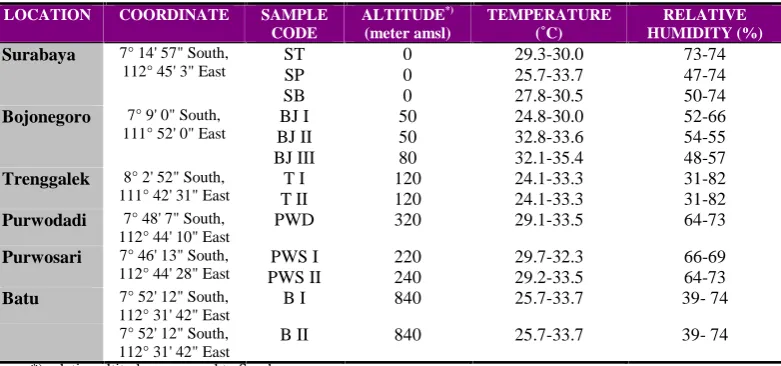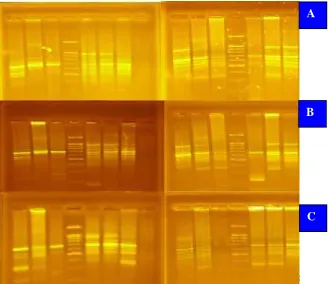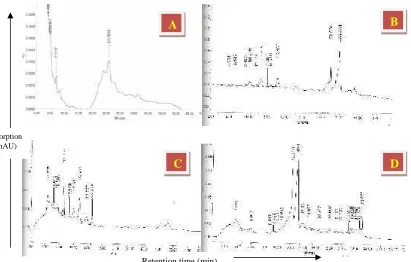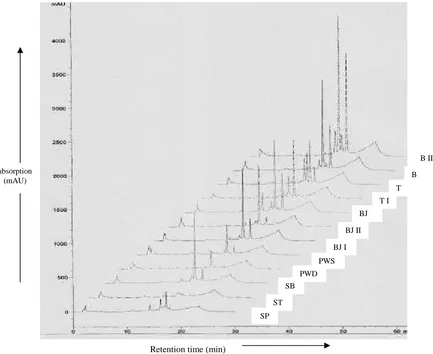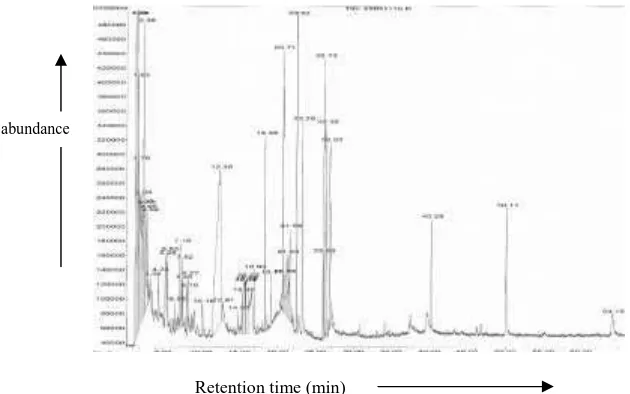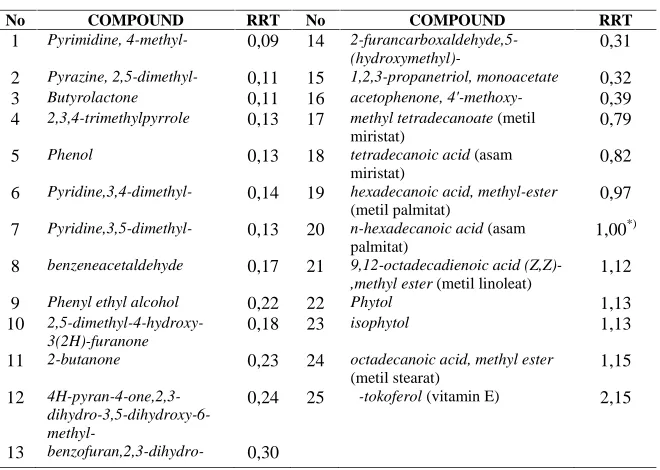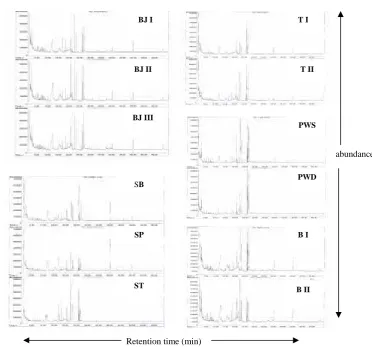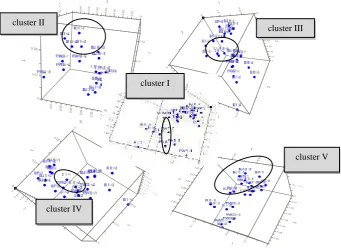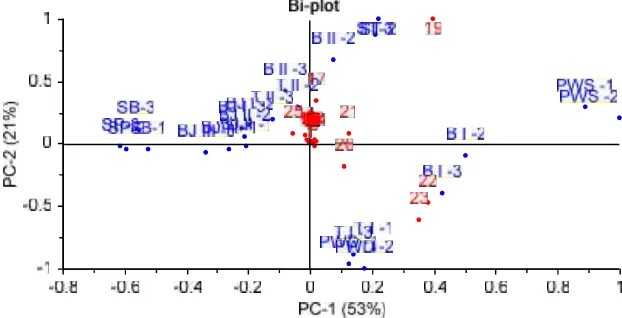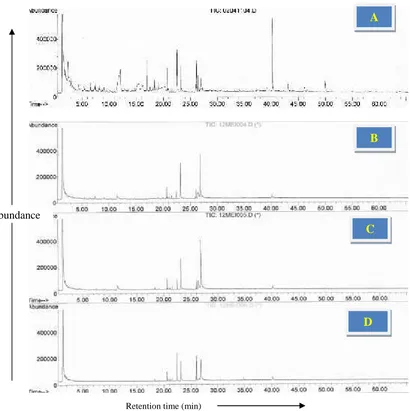Dr. Oeke Yunita, S.Si., M.Si., Apt.
Home institution: Faculty of Pharmacy,
UNIVERSITY OF SURABAYA
Doctorate research at: Postgraduate Program,
AIRLANGGA UNIVERSITY, Surabaya
2012
FINAL REPORT
DOCT ORAT E RESEARCH GRAN T 2 0 0 9
Metabolic and DNA fingerprinting of
Sauropus androgynus,In Food, Foodstuff And Food Supplement,
Dr. Oeke Yunita, S.Si., M.Si., Apt.
Home institution: Faculty of Pharmacy,
UNIVERSITY OF SURABAYA
Doctorate research at: Postgraduate Program,
AIRLANGGA UNIVERSITY, Surabaya
2012
DOCT ORAT E RESEARCH GRAN T 2 0 0 9
Metabolic and DNA fingerprinting of
Sauropus androgynus,In Food, Foodstuff And Food Supplement,
FORM 3A
* Please submit all manuscripts that you have drafted.
Name of PI : Dr. Oeke Yunita, S.Si., M.Si., Apt.
Signature
REPORT
–
COVER PAGE
Type of report(circle one) 1. Progress Report. Design, Protocol, Instrument & progress report
2. Final Report. Publishable manuscript(s)*, final activity report & Budget report
3. Last 20% finance report
Proposal Code D0042009
Name of principal investigator (PI) Dr. Oeke Yunita, S.Si., M.Si., Apt.
Name of institution University of Surabaya
Title of proposal Metabolic and DNA Fingerprinting of Sauropus androgynus, in
Food, Foodstuff and Food supplement, as a Lactagogum for Increasing Human Breast Milk Production
Duration of the funded project (start and end date)
Start date : January 1, 2010 End date : June 30, 2012 Duration of the report
(start and end date)
Start date: January 1, 2010 End date : March 13, 2012 Contact address of PI (mail address) Wiguna Tengah 19 no. 1 Surabaya
Telephone 031-71670899
Fax
--E-mail oeke.ynita@gmail.com
Mobile 081-216945749
Date submission of report 13 March 2012
Name of Advisor Prof. Dr. rer. nat. Mochammad Yuwono, MS.
FORM 3A
* Please submit all manuscripts that you have drafted.
Name of PI : Dr. Oeke Yunita, S.Si., M.Si., Apt.
Signature
REPORT
–
COVER PAGE
Type of report(circle one) 4. Progress Report. Design, Protocol, Instrument & progress report
5. Final Report. Publishable manuscript(s)*, final activity report & Budget report
6. Last 20% finance report
Proposal Code D0042009
Name of principal investigator (PI) Dr. Oeke Yunita, S.Si., M.Si., Apt.
Name of institution University of Surabaya
Title of proposal Metabolic and DNA Fingerprinting of Sauropus androgynus, in
Food, Foodstuff and Food supplement, as a Lactagogum for Increasing Human Breast Milk Production
Duration of the funded project (start and end date)
Start date : January 1, 2010 End date : June 30, 2012 Duration of the report
(start and end date)
Start date: January 1, 2010 End date : March 10, 2012 Contact address of PI (mail address) Wiguna Tengah 19 no. 1 Surabaya
Telephone 031-71670899
Fax
--E-mail oeke.ynita@gmail.com
Mobile 081-216945749
FORM 3D
Dr. Oeke Yunita, S.Si., M.Si., Apt.
Home institution: Faculty of Pharmacy,
UNIVERSITY OF SURABAYA
Doctorate research at: Postgraduate Program,
AIRLANGGA UNIVERSITY, Surabaya
2012
ACKNOWLEDGEMENT
We express our gratitude to the Danone Institute Indonesia (DII) for its research grant on 2009 which fully supported this research.
EXECUTIVE SUMMARY
Sauropus androgynus (Indonesian name: katuk) is traditionally used by Indonesian
people to increase and accelerate human breast milk production. There are many publications
that show the lactagogum (agent for increasing breast milk production) effect of this plant.
There are many products at the market, contain extract of the S.androgynus produced by pharmaceutical manufacture which are claimed has a function as lactagogum.
Despite its important effect on the breastfeeding program, there are also many
investigations that reveal the side effect of this plant in Taiwan and Japan. In these countries, people use this plant for reducing body weight. After a wide-spread, prolonged and
unregulated use of this plant, a few patients have died and many have developed protracted chronic respiratory failure.
This research will perform chemical assessment, by metabolic fingerprinting with LC-MS and GC-MS, and genetic assessment, by DNA fingerprinting with RAPD method, for
ensuring the safety of S.androgynus as a lactagogum, which is used in food, foodstuff and food supplement.
The metabolic profiles of S.androgynus in food, foodstuff and food supplement will be compared each other for obtaining the specific chemical compound (s) which assumed cause the side effect of S.androgynus. For completing this assumption, DNA patterns in food,
foodstuff and food supplement, will be compared for obtaining the possibility of different variety or cultivar (s) of S.androgynus within the products.
The research in this proposal is the early research for research project which has general aim to ensure the safety of S.androgynus which is used as a lactagogum at Indonesia.
Expected output of this research will enhance the researcher’s capacity on
fingerprinting of the metabolites and DNA. The dissemination of this research could also
strengthen the education and research capacity of the researcher’s institution, so it could
develop the scientific community network. Research output could also contribute
recommendations for policy decision at Indonesia, about the safety of herbal preparations. From this research, the researcher could also build a system for safety or quality control of plant which are used as herbal medicine and herbal supplement. This system will
give a feasibility to control the product and process quality in the herbal medicine industry or herbal supplement industry, in the production chain, beginning from raw material,
I. INTRODUCTION
In the battle to eradicate poverty in developing countries and in situations of disaster
or food insecurity, one small step would ensure the food security is breastfeeding every newborn. Breastfeeding would provide the best nutrition, the greatest infection protection, the
most illness prevention and the greatest food security and psychological protection for the infant (Lawrence, 2007).
Except the benefits for individual health, breastfeeding provides significant social and economic benefits to the nation, including reduced health care costs and reduced employee
absenteeism for care attributable to child illness. The significantly lower incidence of illness in the breastfed infant allows the parents more time for attention to siblings and other family duties and reduces parental absence from work and lost income. The direct economic benefits
to the family are also significant, by saving money per child for infant formula purchases for the first of year after birth (American Academy of Pediatrics, 1997).
Promotion of breastfeeding is a global priority to ensure food security and good health for infants in the first 6 months of life. In 2002, The World Health Organization
(WHO) based on a systematic review of scientific evidence, recommended exclusive breastfeeding to newborns from birth through to 6 months of age and that breastfeeding
should be extended to 2 years of age along with appropriate complementary foods (Lee et al., 2007).
The potential risk factors leading to lower breastfeeding rate and early cessation of breastfeeding were found to increase with rapid urbanization and modernization of a society, women having full time work, which increasing their workloads physically and emotionally,
and lacking a role model from mothers or mothers-in-law. This may be attributable to the fact that in metropolitan areas, the use of infant formula is regarded as elite, sophisticated,
affordable and convenient (Beasley and Amir, 2007; Lee et al., 2007).
The Maternal and Child Health Study (2001) showed that only 47.5 % infants 0– 3
months and 14.2 % infants 4 – 5 months were exclusively breastfed and this percentage getting lower at 2008 until only 14 % infants 0 – 6 months were exclusively breastfed
(Supraptini et al., 2003; Media Indonesia, 2008).
The survey reported that 38 % of mothers stop giving mother’s breast milk because of
the lack of the mother’s breast milk itself (Sa’roniet al., 2004).
Sauropus androgynus (Indonesian name: katuk) is traditionally used by people to
increase and accelerate mother’s breast milk production. Extract of S.androgynus leaves had
shown lactagogum effect at the dosage 631.6 mg/kg rat’s body weight or 900 mg/day for
breast milk significantly. Extract of the S.androgynus leaves (900 mg each day) during 15
days, can increase the mother’s breast milk production up to 50.7 %, start on the second or
third day postpartum, compared with placebo. There are many products contain extract of the
S.androgynus produced by pharmaceutical manufacture which are suspected has a function as
lactagogum, for increasing breast milk production (Sa’roni et al., 2004; Azis and
Muktiningsih, 2006).
S.androgynus was first introduced in Taiwan at 1988 and was prepared in some
restaurants only as a fried dish. It was cultivated locally on a commercial scale and uncooked
S.androgynus juice was widely advertised as a ‘natural diet vegetable containing large
amounts of nutrients and good for rapid weight reduction’ (Geret al., 1997; Kao et al., 1999).
Since 1994 an endemic chronic obstructive pulmonary disease (COPD) has developed
in Taiwan after a wide-spread, prolonged and unregulated use of a body-weight reducing vegetable, S.androgynus. Typically, the patients are young or middle aged females with real
or self-assumed weight problems, but without any previous history of respiratory ailments. All conventional treatments for COPD, including steroids and bronchodilators, have been
ineffective in the patients with S.androgynus -induced lung disease. A few patients have died, but many have developed protracted chronic respiratory failure. Because of the chronic debilitation and ineffective conventional treatments, single lung transplants were performed
as the last report in patients at the National Taiwan University Hospital. Some cases suffering from temporary insomnia, difficulty breathing or death after ingestion of the S.androgynus
vegetable, have also been reported to the National Poison Center of Taiwan since August 23, 1995 (Lin et al., 1996; Chang et al., 1998).
A new outbreak of S.androgynus -associated bronchiolitis obliterans (BO) also occurred in Japan. In Japan, cultivation of S.androgynus started in 1996 and recently it has
also been used for weight control by young and middle-aged women, similar to Taiwan (Oonakahara et al., 2005).
To further evaluate the association between S.androgynus and BO syndrome, a hospital-based case-control study was conducted at Veteran General Hospital-Kaohsiung between April and September 1995. The result of this study revealed that a larger total
amount of S.androgynus compsumtion, preparation of S.androgynus food without cooking and ingesting S.androgynus food prepared by a vendor were the significant risk factors
associated with BO syndrome (Ger et al., 1997).
In early August 1995, the Bureau of Food Sanitation of the Republic of China urged
the public to stop consuming S.androgynus until epidemiologic and/or animal studies confirmed its safety (Ger et al., 1997).
which is frequently used by Indonesian people as food, foodstuff and food supplement. Therefore this research will do early research on metabolic and DNA fingerprinting of
S.androgynus in food, foodstuff and food supplements in Indonesia. This research is only one
small part of the general research which its objective is to ensure the safety of S.androgynus as a lactagogum, for maintaining food security through increasing human breast milk
production.
Research Question
General Question
How can we assure the safety of Sauropus androgynus, which is consumed by Indonesian
people as food, foodstuff and food supplement, for increasing human breast milk production ?
Research Question
1. How is the classification of the metabolic profiles and DNA patterns of Sauropus
androgynus which are cultivated at several different geographic areas on East Java?
2. How is the metabolic profiles of Sauropus androgynus which are consumed by Indonesian
people as uncooked and cooked food with various process of cooking and food storage? 3. How is the metabolic profiles of Sauropus androgynus which are consumed by Indonesian
people as food supplement which contain S.androgynus extract?
Objectives
The aim of this research is to obtain metabolic profiles and DNA patterns of
S.androgynus, in food, foodstuff and food supplement. The metabolic profiles of
S.androgynus in food, foodstuff and food supplement will be compared each other for
obtaining the specific chemical profiles which will be tested for the toxicity effect of
S.androgynus, in the next research. For completing this assessment, DNA patterns in food,
foodstuff and food supplement, will be compared for obtaining the possibility of different
variety or cultivar (s) of SA in the SA product within.
In the present study, the Internal Transcribed Spacer (ITS) sequences of S.androgynus
nuclear ribosomal DNA (rDNA) were amplified by Random Amplified Polymorphic DNA (RAPD) method to explore the original plant species from which they were derived. The
metabolomic study was performed by High Performance Liquid Chromatography-Photodiode Array (HPLC-DAD) and Gas Chromatography-Mass Spectrometry Detector (GC-MSD). We then observed the influence of several cooking process and food storage towards metabolic
II. METHODOLOGY
This research project had been conducted for exploring the metabolic profiles and DNA patterns of Sauropus androgynus as a food, foodstuff and food supplement.
2.1 Sampling Method
Sauropus androgynus were collected during June–July, 2010, from several locations at six areas with different geographic conditions (Surabaya, Trenggalek, Bojonegoro,
Purwodadi-Purwosari, Batu). Almost all samples were obtained from individual gardens except sample from Batu was obtained from Balai Materia Medika. All the samples were
authenticated by the Center of Information and Development of Traditional Medicine (PIPOT), Faculty of Pharmacy, University of Surabaya, East Java, Indonesia.
Leaves of Sauropus androgynus were collected, washed free of dirt, mopped dry and quickly stored at -80 ºC until used.
2.2 DNA Fingerprinting of Sauropus androgynus
2.2.1 DNA Isolation
Genomic DNA isolation was modified from Yunita (2010). Fresh leaves 1.0 g were ground and 500 µl of β -mercaptoethanol and 3500 µl of 2X CTAB solution (2% CTAB, 0.1 M Tris-HCl, 1.4 M NaCl) were added. The mixture was incubated at 55 ºC for 40 min
with occasional inversion and then cooled at room temperature and further incubated at 55 ºC for 15 min. A 3500 µl of chloroform : isoamyl acetate (24:1 v/v) was added, incubated at
room temperature for 30 min and then shaken for 10 min. After centrifugation at 4000 rpm for 30 min, 500 µl of the upper phase was subsequently mixed with 3500 µl phenol : chloroform :
isoamyl acetate (25:24:1 v/v). 500 µl of the upper phase was mixed with 3500 µl of chloroform : isoamyl acetate (24:1 v/v) and then was mixed and centrifuged 4000 rpm for
30 min. Upper phase was mixed with 50 µl CTAB 10 % (65˚C) and 500 µl 65˚C ppt buffer
(1% CTAB, 0.05 M Tris buffer pH 8, 0.01 M EDTA pH 8), then the DNA-CTAB complex
was formed at room temperature for 15 min. The mixture was centrifuged at 13,000 g at 4 ºC for 15min and DNA pellet was mixed with 500 µl of 1 M NaCl-TE and incubated at 55 ºC until DNA dissolved. Isopropanol 500 µl was added in this mixture. After centrifugation
13000 g at 4 ºC for 15min, the DNA pellet was washed twice with 600 µl of 70 % ethanol and
DNA was dissolved in 75 µl water free nuclease and kept at –20 ºC until used.
2.2.2 Amplification of DNA Fragment by PCR
DNA was pre-denatured at 95 ºC for 2 min, cycled 35 times at 95 ºC for 30 sec, 57 ºC for 1 min and 71 ºC for 2 min in a thermocycler. The final extension cycle allowed an additional
incubation for 5 min at 71 ºC, as in Yunita (2010). The amplification reaction of the ITS region by RAPD primer, was modified from Verma et al. (2004), while the mixture contained 12.5 µl GoTaq® Green Master Mix (Promega) which contain GoTaq® DNA polymerase
supplied in 2X Green GoTaq® Reaction buffer (pH 8.5), 400 µM dATP, 400 µM dGTP, 400 µM dCTP, 400 µM dTTP and 3 mM MgCl2.; 3.5 µl RAPD primer and 9 µl PCR result
from PCR with ITS primers method in 25 µl reaction volume. The mixture was cycled 44 times at 94 ºC for 1 min, 35 ºC for 1.5 min and 72 ºC for 1.5 min in a thermocycler. The final
extension cycle allowed an additional incubation for 5 min at 72 ºC.
2.2.3 Visualization of DNA Pattern by Electrophoresis
Amplification products were separated by electrophoresis through 1.5 % agarose gels in 0.5 X TBE buffer, visualized and imaged after staining with ethidium bromide.
2.2.4 Statistical Analysis
Each amplification product (band) was considered to be a RAPD marker. Number one
will be attributed to band presence and zero to absence. The binary data set was used to calculate the similarity index and to assemble the corresponding similarity matrix. The matrix obtained was used to generate a dendogram. All the analysis were performed with the aid of
the SPSS 11.5 for Windows computer program.
2.3 Metabolic Fingerprinting of Sauropus androgynus
2.3.1 Preparation of Methanol Extract
Leaves of Sauropus androgynus were collected, washed free of dirt, mopped dry and quickly stored at -80 ºC until used. 500,0 mg of mature-leaves were mixed and grounded in a
mortar and pestle and 5,0 ml of methanol was added. The mixture was homogenized by vortex and sonicated for 20 minute and mixed thoroughly. The mixture was then be
centrifuged at 3000 g for 1 min and filtered. Before being analysed with GC-MSD, HPLC-DAD or LC-MS, sample extract was evaporated with nitrogen gas and diluted with methanol, respectively.
2.3.2 Food Preparation from Sauropus androgynus
The leaves of Sauropus androgynus from one location (Surabaya) had been processed into food with variation methods, such as uncooked and cooked; various duration of cooking
2.3.3 Preparation of Food Supplement based on S.androgynus Extract
Two or three tablets (caplets) of S.androgynus were weighed and crushed. After a
proper homogenization, 500.0 mg of powdered food supplement (tablets, caplets or capsules) which contained S.androgynus was added with 5.0 ml of methanol. The mixture was homogenized by vortex and sonicated and mixed thoroughly. The mixture was then be
centrifuged at 3000 g for 5 min and filtered through a 0.45 μ m nylon membrane prior to
analysis.
2.3.4 Optimization of the Analysis Condition on HPLC
Various eluting conditions for separations had been tried and a gradient of several
solvents will be employed to achieve well separation. Several kinds and compositions of mobile phase will be used to find the optimum condition with several acid / base compounds
for regulation the separation pH.
2.3.5 HPLC-DAD and LC-MS Condition
Metabolomic study was performed on an Agilent High Performance Liquid Chromatography Instrument (HPLC 1100 Series) (analytical column: Merck Lichrospher®
100, RP-18, 5μ m, 250.0mm X 4.0mm, 5μ m); injected sample volume: 20.0μ l; mobile phase:
methanol (A) and water (B) using a gradient program of 90% (B) in 0-15 min; 40% (B) in
15-20min; 20% (B) in 20-25min and 90% (B) in 25-30min; flow rate:1.0ml/min; temperature: 30 ˚C, measured at λ 214nm, 254nm, 280nm, 360nm, and 370nm). Further analysis of
chemical identity was performed on a Waters Liquid Chromatography-Mass Spectrometry Instrumen (analytical column: Xterra®MSC18 5.0 µm; 2.1mm x 100 mm), with the modified
method as described above.
2.3.6 GC-MSD Condition
Metabolomic study was performed on an Agilent Gas Chromatography instrument
(Agilent 6890) coupled to a Agilent mass spectrometry detector (5973 network), NIST mass spectrometer database (Wiley, W8N05ST.L) and a GC/MS solution workstation. One
microlitre of the extract was injected into a HP-5 capillary column (30 m x 250 μ m i.d, 0.25 μ m film thickness; 5 % polyxylosane; Agilent J&W scientific, Folsom, CA) in the
splitless mode. The injection temperature was set to 270 ˚C; and the ion source temperature
was adjusted to 250 ˚C; initial GC oven temperature was 80 ˚C to 180 ˚C at a rate of
5 ˚C min-1, then the GC oven temperature was raised to 250˚C with 4˚C min-1 during 28.5 min. Helium was the carrier gas with a flow rate set at 1.3 ml min-1. The measurements were
The validation of the analytical method was carried out with sample solutions. The instrument/injection precision (repeatability) was obtained by analyzing the variations of
relative retention time and relative peak area of six injections.
2.3.7 Metabolic Profile Data Processing
Chromatogram acquisition, automated peak deconvolution and library searches were performed using Agilent GC/MS workstation in combination with the Automated Mass
Spectral Deconvolution and Identification System (AMDIS 32, version 2.69, 2010). Few modifications on the parameters settings of the AMDIS software were done to permit best
signal/noise ratio. Compounds were tentatively identified by comparing their mass spectra with those of the National Institute of Standards and Technology (NIST) library. The libraries
were created after analyses and deconvolutions of the raw data. Each sample was analyzed and the data were save individually as a *.msl library. Thus all samples produced several
individual libraries that could be combined and used for statistical analysis.
2.3.8 Multivariate Statistics
All the GC-MSD raw data were exported into Microsoft Office Excel 2007 in a table which contained the resulting three-dimentional matrix involving peak index (RT-m/z pair),
sample names (observations) and peak area percent were introduced into The Unscramble software package (Unscramble-X® ver 10.1, CAMO software, AS), which utilizes Principle
Component Analysis (PCA) to display natural separation among the S.androgynus samples by
visual inspection of 3-D score plots. Furthermore, hierarchical cluster analysis (HCA) was
applied in the software package to estimage linkages between different classes within the data set. Euclidean distance on the PCs with Ward’s linkage methods was used to derive a
similarity matrix, which was processed by agglomerative or divisive clustering algorithms to construct a dendogram.
III. RESULTS AND DISCUSSION
3.1 Sampling
S.androgynus were collected from six areas with different geographic conditions at
Table 1 Sampling Condition of S.androgynus from East Java
All plant samples were collected and authenticated as Sauropus androgynus, based on their morphological structures, as seen on figure 1. This research used mature leaves, which
were characterized by dark green color because this leaves contain more secondary metabolites than young leaves, therefore could give more complete analysis about
S.androgynus. All leaves were harvested in the morning, before 12.00 p.m, when the
photosynthetic process was still happening. After harvesting, all leaves were transported into
the laboratory in the cold condition (-20˚C) for preserving their freshness and keep at -80˚C
until used.
Fig. 1. Sauropus androgynus (Indonesian names: katuk)
3.2 DNA Isolation
Genomic DNA from accessions of S.androgynus was isolated using the method as in
Yunita (2010), for isolation the DNA of Piper betle. The modified method was performed in this research including the usage of phenol for lowering secondary metabolic contamination
at DNA isolation process.
The DNA purity and concentration of isolated DNA from fresh leaves from many
The isolated DNA of fresh leaves from Surabaya Timur (ST), was used for optimization the amplification process with ITS primers and screening for RAPD primers.
For amplification purpose, the amount of fresh leaves for DNA isolation is about 1.0 g because this amount of plant materials would give large yields without decrease their DNA purity. Large yield is very important in RAPD method because this method will need
many sample DNAs.
3.3 PCR-RAPD on ITS region
Our preliminary work had revealed that amplification the DNA of S.androgynus with
the RAPD primers directly often resulted the smear band (data not shown), but after amplification of the ITS region of S.androgynus, we could get the distinct and clear bands on
agarose gel after staining with ethidium bromide. Yunita (2010) assumed that the DNA genome is too long and complex so that the RAPD primers could anneal to many sites at the
DNA so that the yield of amplification is too low; this was shown with the smear band at agarose gel after electrophoresis method.
The isolated DNA of fresh leaves of S.androgynus, then was amplified with ITS primers by Polymerase Chain Reaction (PCR) Method. These primers amplify the entire ITS region of S.androgynus’DNA.
ITS regions of DNA were subsequently amplified with twenty decamer primers by PCR-RAPD method for preliminary research to obtain the best primers which gave result
clear and sharp profiles of DNA banding pattern after gel electrophoresis process.
Three primers (OPF-07, OPF-12,OPF-15) resulted clear and sharp profiles of DNA
1 2 3 4 5 6 7 8 9 10 11 12 13 14 15
Fig 2. RAPD profiles from ITS regions on DNA of S. androgynus accessions, with primers
OPF-7 (A), OPF-12 (B), OPF-15 (C). 1:SB; 2:SP, 3:ST, 4:marker 100 bp ladder, 5:T-I; 6:T-II, 7: B-I, 8:blank, 9:BJ-I, 10:BJ-II, 11: BJ-III, 12: marker 100 bp ladder, 13: PWS-I, 14:PWS-II, 15:PWD
After visualizing by UV light transluminator, BioDocAnalyze Biometra helped to measure the weight of DNA bands comparing with the marker 100 bp ladder. The
measurement result showed the monomorphic band, 600 – 700 kb in samples of
S.androgynus. In the next research, this band could be investigated further for obtaining
specific biomarkers of S.androgynus.
Examination of RAPD polymorphisms of the leaves samples by the use of arbitrary
primers, was accomplished by primer OPF-07, OPF-12 and OPF-15. The results of statistical analysis indicate that RAPD patterns among the samples had high similarity (0.786-0.895), as
indicated in figure 3.
Fig. 3. Dendogram showing diversity of Sauropus androgynus’ samples based on
RAPD of ITS regions
A
B
A dendogram of DNA banding pattern from S.androgynus samples revealed that
genetic assessment by DNA fingerprinting, could distinguish S.androgynus cultivars more precisely than morphological assessment. There is no literature review could distinguish
S.androgynus cultivars based on their morphological characteristics. All S.androgynus
samples were authenticated by Center of Information and Development of Traditional Medicine at species level and they could not be differentiated at variety and locality level.
Mandal et al. (2007) stated that molecular identification could support the identification based on morphology for correctly designating different accessions of the same species. This
method could support the assessment of raw materials in traditional medicine industry for assuring the quality of raw material and product.
DNA banding pattern of S.androgynus from Surabaya Timur (ST) and Bojonegoro (BJ-III) show the highest similarity, although the samples were collected from two locations
with different geographical conditions, such as relative altitude, temperature and relative humidity.
Despite the highest similarity, sample from Purwodadi (PWD) show the lowest similarity of DNA banding pattern comparing with other samples.
This research showed that environmental conditions might not be the major factor that influence the differences between accessions. The slight differences on DNA banding patterns of samples might be more influenced by different genetically accessions of
S.androgynus samples collected from several locations. Asmarayani and Pancoro (2005) also
stated that human interference in plant domestication results in botanical evolution diversity.
For the next research, DNA fingerprinting of this plant must be done on the same genetically plant accession, which are cultivated on several locations with different
geographical conditions, to analyze the influence of environmental conditions on genetic diversity of S.androgynus.
3.4 Optimization of the Condition Analysis on HPLC
Methanol was chosen as the extraction solvent for developing S.androgynus fingerprints because it could enhance the extraction efficiency and a variety of compounds
with different polarity can be coextracted effectively. Besides, the interference from sugars in the raw herbs could also be minimized by extraction using methanol (Lu et al., 2005; Qian
et al., 2006).
The extraction methods of S.androgynus were also optimized in our study, before
Fig. 4. HPLC metabolic profile of S.androgynus methanol extract using (A) ultrasonic
extraction, 60 minutes; (B) maceration, 24 hours
In a full-scan experiment, chromatogram of S.androgynus extracted by using ultrasonic wave shows more components information and better separation than S.androgynus
extracted by maceration. Despite the chromatogram profiles, from time and economic point of view, extracting the sample using ultrasonic takes only 60 min and therefore was chosen for
all further analysis.
Various mobile phase for the separations were tried, such as acetonitrile and 0.1% H3PO4(45:55); acetonitrile and 1 % formic acid; methanol and acetic ammonium (80:20) and
also methanol and water, was employed to achieve well separation. It was shown at fig. 5 that mobile phase contain methanol and water could give better separation and more peaks in
the chromatogram profile.
Fig. 5. Chromatogram of S.androgynus methanol extract with various mobile phase by
HPLC-UV: (A) acetonitrile and 0.1% H3PO4(45:55); (B) acetonitrile and 1 % formic acid;
(C) methanol and acetic ammonium (80:20); (D) methanol and water
A
B
A
B
C
D
Retention time (min) Retention time (min) absorption
(mAU)
3.5 Metabolomic study of S.androgynus methanol extract
3.5.1 Metabolomic study by HPLC
The optimized of HPLC condition was utilized to reveal the fingerprint of
S.androgynus leaf extract collected from several different locations at East Java. Photodiode
array detector (DAD) was used in the current study. The detection wavelength at 254 nm gave the best abundance for target compounds within the chromatographic windows, as described
in fig. 6.
The results indicated that their chromatographic patterns were generally consistent
among all samples, especially at retention times under 25 minutes, although the absorption intensity of some peaks was different. This indicated that there was resemblance in terms of
chemical constituents of S.androgynus sample from several locations with different geographic condition at East Java. More samples are needed to obtain a more representative
population.
Fig. 6. HPLC Fingerprint of 12 Samples of Fresh S.androgynus from various areas at East
Nevertheless, the results indicated that ST had unique chromatogram profile at retention time (Rt) 18-24 min that had not been similar with the other sample, indicated that
sample ST had unique chemical contents compared with the others.
In order to identify structures of the major chemical components in S.androgynus, the sample was analyzed by Liquid Chromatography Mass Spectrometry (LC-MS) techniques.
ESI in both negative and positive modes were performed. By studying on the characteristic mass spectra of these peaks and comparing with the UV and ESI-MS spectra of authentic
compounds, no Papaverine HCl was identified, as also stated by Bureau of Food Sanitation (Ger et al., 1997) and Yu et al. (2007). Papaverine HCl is a compound which was reported
that assumed can cause respiratory side effects after S.androgynus consumption (Kao et al., 1999).
3.5.2 Metabolomic Study by GC-MSD
Methanol extract of S.androgynus leaves was subjected to GC-MSD analysis, which
resulted the chromatogram in fig 7. According to the comparison of the recorded mass spectra with a MS library (NIST), the main peaks of chromatograms were identified about 25 compounds are listed in table 2., with their relative retention times compared to
n-hexadecanoic acid (palmitic acid) as a stable compound with a high area percent.
Fig 7. Total ionic chromatogram (GC-MSD) of S.androgynus methanol extract obtained with
70 eV using a HP-5MS column (30 m x 0.25 mm) with He gas as the carrier at a flow rate of 1.3 ml min-1
The largest part of the metabolic profile of S.androgynus was composed of fatty acids
and their esters, such as myristic acid, palmitic acid, methyl-linoleic, methyl-stearic. Other dominant components such as phytol and isophytol were also found in the S.androgynus methanol extract, as described in table 2.
abundance
Table 2 Chemical Compound in S.androgynus Methanol Extract (NET>80)
No COMPOUND RRT No COMPOUND RRT
1 Pyrimidine, 4-methyl- 0,09 14 2-furancarboxaldehyde,5-
(hydroxymethyl)-0,31
2 Pyrazine, 2,5-dimethyl- 0,11 15 1,2,3-propanetriol, monoacetate 0,32 3 Butyrolactone 0,11 16 acetophenone, 4'-methoxy- 0,39 4 2,3,4-trimethylpyrrole 0,13 17 methyl tetradecanoate (metil
miristat)
0,79
5 Phenol 0,13 18 tetradecanoic acid (asam
miristat)
0,82
6 Pyridine,3,4-dimethyl- 0,14 19 hexadecanoic acid, methyl-ester
(metil palmitat)
0,97
7 Pyridine,3,5-dimethyl- 0,13 20 n-hexadecanoic acid (asam
palmitat)
1,00*)
8 benzeneacetaldehyde 0,17 21 9,12-octadecadienoic acid (Z,Z)-,methyl ester (metil linoleat)
1,12
9 Phenyl ethyl alcohol 0,22 22 Phytol 1,13 10
2,5-dimethyl-4-hydroxy-3(2H)-furanone
0,18 23 isophytol 1,13
11 2-butanone 0,23 24 octadecanoic acid, methyl ester
(metil stearat)
1,15
12 4H-pyran-4-one,2,3- dihydro-3,5-dihydroxy-6-
methyl-0,24 25 α -tokoferol (vitamin E) 2,15
13 benzofuran,2,3-dihydro- 0,30
RRT = relative retention time, compared to palmitic acid *)
compound used as reference standard
Reproducible chromatographic profile of S.androgynus could be showed by conducting a method validation on the developed GC-MS analysis. Method precision was
investigated by repeatedly analyzing the same set of samples, with the values of relative standard deviations (RSDs) for relative retention time (RRT) and relative peak area (RPA),
respectively, reported a less than 0.1 % and 20 % (n=6). These results indicate that the method is reliable and applicable to the analysis of metabolic profile of S.androgynus.
Typical GC/MS chromatograms of samples from different 5 areas at East Java were illustrated in fig 8. The total ion chromatograms (TIC) of S.androgynus samples are showed
in this figure, which the x-axis indicates time and the y-axis indicates the total ion signals. Single mass spectra were obtained from every time window and all signals were plotted as a
Fig. 8. GC-MSD metabolic profile of 12 samples of S.androgynus from East Java: (B) Batu,
(BJ) Bojonegoro, (PWD) Purwodadi, (PWS) Purwosari, (SB) West Surabaya, (SP) Center Surabaya, (ST) East Surabaya
The output data set was organized in a three-dimensional matrix encompassing relative retention times, sample locations (observations) and peak area percentage (variables).
Raw data file from the chromatogram could be read with AMDIS and based on user selected parameters, perform the deconvolution of peaks based on the MS data. The analyses reveal
that although some components could be identified in several samples, the majority of the products were present in only few ones, resulting in some degree of uniqueness of the profiles, allowing for their distinction.
The quantitative data of GC/MS analyses were exported to the software Unscramble-X®ver 10.1. The data set was pre-processed by standardization to give all variables the same
variance. Then PCA was used to transform the original measurement variables into new variables called Principle Components (PC). The scores scatter plot of the first three PCs
calculated using all integrated peaks is shown in fig. 9. Several samples are noted in five clusters in 3-D score plot, while this movable modelling could show clearly the relationship
among the samples in each cluster better than in 2-D score plot between PC 1 and PC 2. It was noticeable that the samples were clustered in different domains, which represented the
BJ I
BJ II
BJ III
T I
T II
PWD PWS
SB
SP
ST
B I
B II
Retention time (min)
similarities and differences of different source of samples. The PC scores were used to identifiy the geographical origin of samples. S.androgynus from lowland area, such as
Surabaya and Bojonegoro are grouped in one cluster, except sample from East Surabaya (ST).
Fig. 9. PCA 3-D score plot of metabolic profile of S.androgynus from different areas at East
Java, showing the first three principal components: (B) Batu, (BJ) Bojonegoro, (PWD) Purwodadi, (PWS) Purwosari, (SB) West Surabaya, (SP) Center Surabaya, (ST) East Surabaya
Hierarchical Cluster Analysis (HCA) of S.androgynus samples by Euclidean distance separated the samples into five clusters (fig. 10.), with one cluster comprising only sample
from Purwosari (PWS). Samples from lowland areas, such as Surabaya (except East Surabaya, ST) and Bojonegoro are clustered together in Cluster V. Samples from Batu,
highland area, are clustered in Cluster II. In this study, HCA had clustered samples from Trenggalek, TI and TII, into two different clusters, each of them is clustered with samples
from Purwodadi (PWD) or East Surabaya (ST) respectively, which suggests that sample T I has similar metabolic profiles with samples PWD and sample T II is similar to sample ST.
cluster V
cluster IV
cluster III cluster II
Fig. 10. Dendogram showing the Hierarchical Cluster Results for the Metabolic Profiling of
S.androgynus from 12 locations, using Euclidean Distance and Average Linkage : (B) Batu,
(BJ) Bojonegoro, (PWD) Purwodadi, (PWS) Purwosari, (SB) West Surabaya, (SP) Center Surabaya, (ST) East Surabaya
From the PCA-Bi Plot which combine the score plot and loading plot on fig.11, the following substances with the greatest influence on the model were extracted, which can be
seen as characteristic metabolites for all samples from different geographic areas. PC1 and PC2 could explain 53 % and 21 % of sample diversity, respectively.
This study found seven characteristic compound for all samples such as methyl miristate (17), methyl palmitate (19), palmitic acid (20), methyl-linoleic (21), phytol (22),
isophytol (23) and vitamin E (25), as stated in fig. 11. These compounds had relatively higher area percent than all compounds in S.androgynus samples.
Fig. 11. PCA-Bi Plot for all samples of S.androgynus, which 7 characteristic compounds such
as methyl miristate (17), methyl palmitate (19), palmitic acid (20), methyl-linoleic (21), phytol (22), isophytol (23) and vitamin E (25) : (B) Batu, (BJ) Bojonegoro, (PWD) Purwodadi, (PWS) Purwosari, (SB) West Surabaya, (SP) Center Surabaya, (ST) East Surabaya
I II
III
IV
Although there are no morphological differences between S.androgynus samples from different areas at East Java, the chromatograms of different samples were found generally
different, with some common characteristics both in retention times and abundance of components. This clearly indicated that different geographical areas could influence the metabolic reaction of S.androgynus, by changing the metabolic pathway or modifying the
enzyme responsible for the metabolic process. Further research had also showed that
S.androgynus from several different areas on East Java, Indonesia, had different profiles of
DNA banding patterns (Yunita and Sulisetiorini, 2011). Accordingly, it could be assumed that difference of metabolic profile among the samples was caused not only by different
environment condition, but also by different of gene characteristic of samples.
Metabolomic study of S.androgynus by GC-MSD shows that it consisted of several
major compounds such as fatty acids, diterpen and vitamin. Some of the detected metabolites can be used as biochemical markers for the identification and differentiation between
samples. Twenty five chemical constituents in S.androgynus had been identified by matching their mass spectrum with reference at NIST library, while palmitic acid and phytol are the
dominant compounds, as stated by Agustal et al. (1997), Ching and Mohamed (2001), Bağci
(2007) and Ogunlesi et al. (2009).
S.androgynus from several areas were determined by GC-MS and therefore, grouped
and classified by Principle Component Analysis (PCA) and Cluster Analysis, respectively. The sample from Purwosari (PWS) alone was merged into one group or a cluster and those of
the other samples were merged into the other cluster. Dissimilarity of PWS from other samples could be caused by the difference of area peak percent among the metabolites in
PWS samples. GC-MSD analysis had shown that several metabolites in PWS had area peak percent c.a. 3-5 times bigger than those in other samples (data not shown).
According to their metabolic profiles, samples from East Surabaya (ST) and Trenggalek II (T II) show the closely relationship in score plot of PCA and in the dendogram.
We assumed that their closely relationship is due to the same environment condition. On the other hand, samples from Trenggalek I (T I) was grouped in the same cluster with samples from Purwodadi (PWD), is due to similarity of environment condition at the two areas, while
they were cultivated at mountainous area.
The influence of food processing of S.androgynus were studied in this research, as
described in fig. 12 , such as cooked S.androgynus by boiling 40˚C 15 min and 100˚C 5min.
Food storage of cooked S.androgynus during 15 hours was also studied for observing the
Fig. 12. Fingerprints of the methanol extract and several food preparation and storage of
S.androgynus by GC-MSD: (A) methanol extract; (B) boiled 40˚C 15 min; (C) boiled 100˚C 5
min; (D) food storage during 15 hours
Metabolic profiles of cooked S.androgynus had shown the same pattern (Rt = 20-30 min) with the fresh leaves extract, although the absorption intensity of all peaks had
decreased. This result is similar with Rahmat et al. (2003) which had found that boiling the leaves may deteriorate the active compounds such as flavonoid, terpenoid, lignin, sulphide,
polyphenol, carotenoid, coumarin, saponin, curcumin, vitamins and sterol.
Many brands of herbal supplement products based on S.androgynus have been
available in the Indonesian markets, therefore chromatographic profile of several commercial products were compared with profile of methanol extract from fresh leaves, as seen in fig. 13.
Retention time (min)
abundance
A
B
Fig.13. GC-MSD Fingerprints of the methanol extract and commercial product of
S.androgynus. (A) methanol extract; (B) the tablet BD; (C) caplet LS; (D) capsule AF
Most of the contents in the fresh leaves of S.androgynus are generally higher than that
of its commercial product. Probably the differences were attributed to the lost or decomposition during the drying process in the formulation technology, as also stated by
Meng et al. (2005) about fresh Houttuynia cordata dan its dried counterpart.
IV. CONCLUSION AND RECOMMENDATION
Safety assessment is one of the key issues in the modernization of Indonesian herbal
supplement. The early investigation at this research is to find the system for controlling the identity of raw material on industry by using molecular study with RAPD method on ITS
region of DNA and metabolomic study with HPLC and GC-MSD of Sauropus androgynus accessions from several locations, at East Java, Indonesia.
Random Amplified Polymorphic DNA (RAPD) method could generate different DNA fingerprint of S.androgynus from several areas at East Java, using ITS region of DNA
as DNA template. DNA banding pattern of S.androgynus from Surabaya Timur (ST) and Bojonegoro (BJ-III) show the highest similarity, although the samples were taken from two
locations with different geographical conditions. Meanwhile, sample from Purwodadi (PWD) show the lowest similarity of DNA banding pattern comparing with other samples. This result showed that environmental condition might not be the major factor could influence the
differences between accessions. abundance
Retention time (min)
A
B
HPLC and GC-MSD could generate different metabolic fingerprint of S.androgynus from several areas at East Java. The results and conclusion generated from the present
developed direct HPLC-DAD fingerprint analysis are generally comparable and consistent with our studies using GC-MSD fingerprint method on S.androgynus.
GC-MSD analysis of S.androgynus samples could show different metabolic profiles
among samples from different geographical areas. Statistical analysis could classify all
S.androgynus samples into 5 clusters that each S.androgynus sample from areas with similar
geographical conditions could be grouped in the same cluster, except S.androgynus sample from Purwosari (PWS).
Further analysis by GC-MSD on cooked S.androgynus and commercial products of
S.androgynus had showed the decreasing in quality and quantity of several metabolites in
S.androgynus.
In the next research, in vitro and in vivo toxicity assay of S.androgynus will be
performed for studying the mechanism of its toxic effect and finding the lethal dose after consumption. Furthermore, the correlation between metabolic profiles of S.androgynus with
its toxic effect will be examined for finding compound (s) in S.androgynus that was highly correlated with its toxicity.
REFERENCES
Agustal, A., Harapini, M., Chairul. 1997. Analisis Kandungan Kimia Ekstrak Daun Katuk
[Sauropus androgynus (L.) Merr.] dengan GCMS, Warta Tumbuhan Obat Indonesia, Vol.3, No.3, 31-33.
American Academy of Pediatrics. 1997. Breastfeeding and the Use of Human Milk, Pediatrics, Vol. 100., No.6, 1035-1039
Asmarayani, R., Pancoro, A. 2005. Phylogenetic Study of Piper L. (Piperaceae) Based on ITS Regions of nrDNA, Floribunda, Vol. 2, No. 8, 2005, 202-208.
Azis, S., Muktiningsih, S.R. 2006 Studi Manfaat Daun Katuk (Sauropus androgynus), Cermin
Dunia Kedokteran, No. 151, 48-50
Bağci, E. 2007. Fatty Acid and Tocochromanol Patterns of Two Euphorbia species
(Euphorbia orientalis L. ve Euphorbia macroclada Boiss.) (Euphorbiaceae), International Journal of Science and Technology, Vol. 2, No. 2, 93-98.
Beasley, A., Amir, L.H. 2007. Infant Feeding, Poverty and Human Development, International Breastfeeding Journal, 2:!4.
Chang, Y.L., Yao, Y.T., Wang, N.S., Lee, Y.C. 1998. Segmental Necrosis of Small Bronchi after Prolonged Intakes of Sauropus androgynus in Taiwan, Am.J. Respir Crit Care
Ching, L.S., Mohamed, S. 2001. Alpha-Tocopherol Content in 62 Edible Tropical Plants, J.Agric. Food Chem, Vol. 49, 3101-3105.
Ger, L.P., Chiang, A.A., Lai, R.S., Chen, S.M., Tseng, C.J. 1997. Association of Sauropus
androgynus and Bronchiolitis Obliterans Syndrome: A Hospital-based Case-Control
Study, American Journal of Epidemiology, Vol. 145, No. 9, 842 - 849
Kao, C.H., Ho., Y.J., Wu, C.L., ChangLai, S.P. 1999. Using 99mTc-DTPA Radioaerosol Inhalation Lung Scintigraphies to Detect the Lung Injury Induced by Consuming
Sauropus androgynus Vegetable and Comparison with Conventional Pulmonary
Function Tests, Respiration, 66:46–51
Lawrence, R.A. 2007. The Eradication of Poverty, One Child at a Time Through Breastfeeding: A Contribution to the Global Theme Issue on Poverty and Human
Development, Breastfeeding Medicine, Vol. 2., No. 4.
Lee, W.T.K., Wong, E., Lui, S.S.H., Chan, V., Lau, J. 2007. Decision to Breastfeed and Early
Cessation of Breastfeeding in Infants below 6 months old–a Population–based Study of 3,204 Infants in Hong Kong, Asia Pac J Clin Nutr, 16(1): 163 -171
Lin, T.J., Lu, C.C., Chen, K.W., Yueh, W.C., Deng, J.F. 1996. How do We Sense about the
Sauropus androgynus Poisonings form the Poison Control Center? Chin Med J
(Taipei), 57:S246
Lu, G.H., Chan, K., Liang, Y.Z., Kelvin, L., Chan, C.L., Jiang, Z.H., Zhao, Z.Z. 2005. Development of High-Performance Liquid Chromatographic Fingerprints for
Distinguishing Chinese Angelica from Related Umbelliferae Herbs, Journal of Chromatography A, 1073, 383-392
Mandal, A.B., Thomas, V.A., Elanchezhi, R. 2007. RAPD Pattern of Costus specious Koen ex. Retz.. an Important Medicinal Plant from the Andaman and Nicobar Islands,
Current Science, Vol. 93, No. 3, 369-372.
Media Indonesia.com. 2008. 86 % Bayi di Indonesia tidak Diberi ASI Eksklusif,
http://www.indonesia.go.id/id - REPUBLIK INDONESIA, [Online], 22 April 2009 Meng, J., Leung, K.S.Y., Jiang, Z., Dong, X., Zhao, Z., Xu, L.J. 2005. Establishment of
HPLC– DAD–MS Fingerprint of Fresh Houttuynia cordata, Chem. Pharm. Bull., 53
(12): 1604 - 1609
Ogunlesi, M., Okiei, W., Ofor, E., Osibote, A.E. 2009. Analysis of the Essential Oil from the
Dried Leaves of Euphorbia hirta Linn. (Euphorbiaceae), a Potential Medication for Asthma, African Journal of Biotechnology, Vol. 8, No. 24, 7042-7050.
Oonakahara, K., Matsuyama, W., Higashimoto, I., Machida, K., Kawabata, M., Arimura, K., Osame, M., Hayashi, M., Ogura, T., Imaizumi, K., Hasegawa, Y. 2005. Outbreak of
Japan – Alert of Food-Associated Pulmonary Disorders from Japan, Respiration, 72:221
Qian, G., Leung, S.Y., Lu, G.H., Leung, K.S.Y. 2006. Differentiation of Rhizoma Et Radix Polygoni Cuspidati from Closely Related Herbs by HPLC Fingerprinting, Chem. Pharm. Bull., 54 (8): 1179–1186
Rahmat, A., Kumar, V., Fong, L.M., Endrini, S., Sani, H.A. 2003. Determination of Total Antioxidant Activity in Three Types of Local Vegetable Shoots and The Cytotoxic
Effect of Their Ethanolic Extracts against Different Cancer Cell Lines, Asia Pacific J. Clin. Nutr., 12 (3): 292–295.
Sa’roni, Sadjimin, T., Sja’bani, M., Zulaela 2004. Effectiveness of the Sauropus androgynus
(L.) Merr., Leaf Extract in Increasing Mother’s Breast Milk Production, Media Litbang
Kesehatan, Volume XIV, No. 3., 20–24.
Supraptini, Lubis, A., Irianto, J. 2003. The Coverage of Immunization and Exclusive
Breastfeeding in Indonesia : Result of National Health Survey 2001, Jurnal Ekologi Kesehatan, Vol. 2., No.2., 249 - 254
Verma, A., Kumar, N., Ranade, S.A. 2004. Genetic Diversity amongst Landraces of Dioecious Vegetatively Propagated Plant, Betelvine (Piper betle L.), J.Biosci., Vol. 29, No. 3, 319-328.
Yu, S.F., Chen, T.M., Chen, Y.H. 2007. Apoptosis and Necrosis are Involved in the Toxicity of Sauropus androgynus in an In Vitro Study, Journal of the Formosan Medical
Association, Vol. 106, Issue 7, 537 -547.
Yunita, O., 2010, Development of Random Amplified Polymorphic DNA method for Identity
Assessment of Piper betle L., Indonesia Toray Science Foundation Seminar, Jakarta. Yunita, O., Sulisetiorini, 2011, DNA Fingerprinting on ITS Region ofSauropus androgynus’
LIST OF TABLES
Table 1. Sampling Condition of S.androgynus from East Java 9 Table 2. Chemical Compound in S.androgynus Methanol Extract (NET>80) 16
LIST OF FIGURES
Figure 1. Sauropus androgynus (Indonesian names: katuk) 10
Figure 2. RAPD profiles from ITS regions on DNA of Sauropus androgynus accessions, with primers OPF-7 (A), OPF-12 (B), OPF-15 (C) 11
Figure 3. Dendogram showing diversity of Sauropus androgynus’ samples based on
RAPD of ITS regions 12
Figure 4. HPLC metabolic profile of S.androgynus methanol extract using (A) ultrasonic
extraction, 60 minutes; (B) maceration, 24 hours 13 Figure 5. Chromatogram of S.androgynus methanol extract with various mobile phase
by HPLC-UV: (A) acetonitrile and 0.1% H3PO4(45:55); (B) acetonitrile and 1 %
formic acid; (C) methanol and acetic ammonium (80:20); (D) methanol and
water 14
Figure 6. HPLC Fingerprint of 12 Samples of Fresh S.androgynus from various areas at
East Java 15
Figure 7. Total ionic chromatogram (GC-MSD) of S.androgynus methanol extract
obtained with 70 eV using a HP-5MS column (30 m x 0.25 mm) with He
gas as the carrier at a flow rate of 1.3 ml min-1 16 Figure 8. GC-MSD metabolic profile of 12 samples of S.androgynus from East Java 17
Figure 9. PCA 3-D score plot of metabolic profile of S.androgynus from different areas
at East Java, showing the first three principal components 18 Figure 10. Dendogram showing the Hierarchical Cluster Results for the Metabolic
Profiling of S.androgynus from 12 locations, using Euclidean Distance and
Average Linkage 19
Figure 11. PCA-Bi Plot for all samples of S.androgynus, which 7 characteristic
Compounds 20
Figure 12. Fingerprints of the methanol extract and several food preparation and
storage of S.androgynus by GC-MSD 21 Figure 13. GC-MSD Fingerprints of the methanol extract and commercial product of
ATTACHMENTS
o
Instruments
1. DNA Fingerprinting - Thermocycler
- Gel Electrophoresis apparatus - Cold Refrigerator (-20˚Cand -80˚C)
- Cold centrifuge - Waterbath - Vortex
2. Metabolomic Study
- High Performance Liquid Chromatography–Ultra Violet (HPLC-UV) - High Performance Liquid Chromatography–Photodiode Array Detector (HPLC-DAD)
- Liquid Chromatography–Mass Spectrometry (LC-MS) - Gas Chromatography- Mass Spectrometry Detector (GC-MSD) - Cold refrigerator (-20˚C)
- Centrifuge - Waterbath - Vortex
o
Ethical clearance
According to the Board of Ethical Clearance Commission at Airlangga
University, this research did not need the Ethical Clearance, because this research was a descriptive research, not an experimental research, which only used a plant
as the research object. This research did not use animal or human as a research subject and did not give an intervention to the research process
